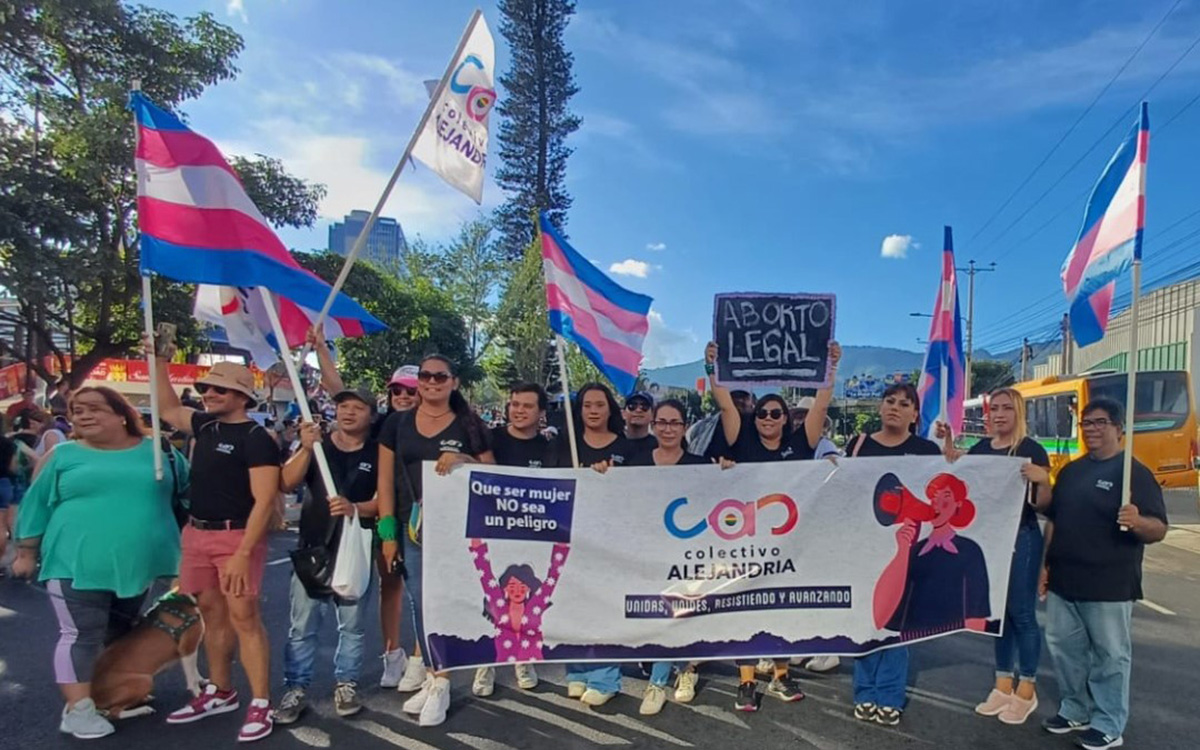Opinions
Christian Nationalism: a ‘prop’ to achieving power?
The drive toward an authoritarian theocracy

“Ladies and Gentlemen, please stand for the Pledge of Allegiance.” I clearly remember this call from a pulpit decades ago because it seemed so odd to hear such a thing in church. Rev. D. James Kennedy, a ballroom dancing instructor in the 1950s who became senior pastor of Coral Ridge Ministries in Fort Lauderdale, Fla., grandly announced: “The Pledge of Allegiance to the Bible!”
Down from the rafters, hanging on wires above the pulpit descended a huge Bible seemingly ablaze. Accompanied by old time miracle-riffs on an organ, Kennedy’s congregants stood with hand over heart to recite a chilling pledge of allegiance to The Word: “I pledge allegiance to the Bible….”. I went to Coral Ridge to see for myself how Kennedy preached about “the infamous men of Sodom who have moved into our churches.” I was one of those men. In the 1980s, when visiting my hometown Dallas, I attended what is still considered the largest LGBTQ church in the world, the Cathedral of Hope. I had helped this church raise money for a chapel to be designed by gay architect Philip Johnson (1906-2005). I had not experienced Christian Nationalists warning about the “men of Sodom moving into our churches” until I saw that giant hanging Bible in Fort Lauderdale.
A pledge of allegiance to a flying Bible seems quaint compared to today’s Christian Nationalist movement, now a pillar of the new Trump presidency, which evangelical leaders liken to a “Red Sea moment in America.” One leader recently compared Donald Trump to Moses parting the Red Sea allowing his people safe passage into a new Promised Land. Amanda Tyler, the lead organizer of the Christians Against Christian Nationalism Campaign of the Baptist Joint Committee for Religious Liberty in Washington, D.C., warns in her new book the U.S. is now at “a high tide of Christian Nationalism.”
Tyler, a devout Baptist from Austin, is direct about the threat Christian Nationalism poses to religious freedom in the U.S. “Christian Nationalism is a political ideology that seeks to fuse American and religious identities….into one set of political beliefs…..It is pernicious and insidious,” she explains in her book, “How to End Christian Nationalism.” Besides being written by a Christian from Texas who asks hard questions, what makes this “how to” book such a good read is Tyler’s rejection of the despondency of the moment. She has no time for that. “We all have a role to play in ending Christian Nationalism,” she explains, by organizing in our communities, churches and with our legislative allies nationwide. This, she emphasizes, includes all who are impacted by Christian nationalism in unequal ways including “people of color, people who are not Christian, LGBTQIA+ people and people who belong to more than one of those identity groups.”
Tyler lays it out: Christian Nationalism exists in a multiverse beyond the old-school haters we once knew and loved. How can one forget “God Hates Fags” Rev. Fred Phelps of the Westboro Baptist Church? When my friend the conservative Republican Sen. Alan Simpson of Wyoming said he favored same-sex marriage, Phelps called him a “Senile Old Fag Lover” (2003). Today, Tyler writes, Christian Nationalists have smoothed those rough edges “using Christianity as a prop to achieving power” in their drive toward an authoritarian theocracy. She explains with cool precision how they evolved into a “well-funded and highly organized political” movement that “points not to Jesus of Nazareth but to the nation….as the object of allegiance.”
A Texan to her Baptist core, Tyler draws from her unique experience working at “ground zero of the culture wars,” the Texas Legislature. Following a proposal to post the Ten Commandments in every classroom in the Texas public school system (which passed in Louisiana) came legislation to replace licensed counselors in the public schools with religious chaplains. Using her “how to” logic she tells the story of Texas State Rep. James Talarico (D-Austin), a committed Christian and seminarian, who successfully opposed the school chaplain bill. Talarico told Tyler that his years as a public school teacher and his Christian faith meant he couldn’t stay silent “in the face of the Christian Nationalist agenda.” Tyler asks, “What would happen if a broad-based coalition of people of faith joined state Rep. James Talarico in saying we don’t want religious instruction happening in our public schools?” Tyler puts this to readers as a basis for action to be carried from the lawmaking trenches of Austin to Washington itself. Tyler’s how-to book rises beyond anger, despondency and “hopium” into concrete ideas for organizing and action among believers and non-believers alike.
Maybe Amanda Tyler’s campaign will take root in states like Oklahoma where the Superintendent of Schools issued a request for vendors to supply 55,000 Bibles (for $59.99 each) that sounded a lot like Donald Trump’s “God Bless the USA” Bible printed in China for $3. The Bibles were to be used for classroom instruction in history, supporters claimed. After a storm of derision, the superintendent’s request was revoked without explanation.
Charles Francis is president of the Mattachine Society of Washington, D.C., and author of “Archive Activism: Memoir of a ‘Uniquely Nasty’ Journey.”
Commentary
Perfection is a lie and vulnerability is the new strength
Rebuilding life and business after profound struggles

I grew up an overweight, gay Black boy in West Baltimore, so I know what it feels like not to fit into a world that was not really made for you. When I was 18, my mother passed from congestive heart failure, and fitness became a sanctuary for my mental health rather than just a place to build my body. That is the line I open most speeches with when people ask who I am and why I started SWEAT DC.
The truth is that little boy never really left me.
Even now, at 42 years old, standing 6 feet 3 inches and 225 pounds as a fitness business owner, I still carry the fears, judgments, and insecurities of that broken kid. Many of us do. We grow into new seasons of life, but the messages we absorbed when we were young linger and shape the stories we tell ourselves. My lack of confidence growing up pushed me to chase perfection as I aged. So, of course, I ended up in Washington, D.C., which I lovingly call the most perfection obsessed city in the world.
Chances are that if you are reading this, you feel some of that too.
D.C. is a place where your resume walks through the door before you do, where degrees, salaries, and the perfect body feel like unspoken expectations. In the age of social media, the pressure is even louder. We are all scrolling through each other’s highlight reels, comparing our behind the scenes to someone else’s curated moment. And I am not above it. I have posted the perfect photo with the inspirational “God did it again” caption when I am feeling great and then gone completely quiet when life feels heavy. I am guilty of loving being the strong friend while hating to admit that sometimes I am the friend who needs support.
We are all caught in a system that teaches us perfection or nothing at all. But what I know for sure now is this: Perfection is a lie and vulnerability is the new strength.
When I first stepped into leadership, trying to be the perfect CEO, I found Brené Brown’s book, “Daring Greatly” and immediately grabbed onto the idea that vulnerability is strength. I wanted to create a community at SWEAT where people felt safe enough to be real. Staff, members, partners, everyone. “Welcome Home” became our motto for a reason. Our mission is to create a world where everyone feels confident in their skin.
But in my effort to build that world for others, I forgot to build it for myself.
Since launching SWEAT as a pop up fundraiser in 2015, opening our first brick and mortar in 2017, surviving COVID, reemerging and scaling, and now preparing to open our fifth location in Shaw in February 2026, life has been full. Along the way, I went from having a tight trainer six pack to gaining nearly 50 pounds as a stressed out entrepreneur. I lost my father. I underwent hip replacement surgery. I left a relationship that looked fine on paper but was not right. I took on extra jobs to keep the business alive. I battled alcoholism. I faced depression and loneliness. There are more stories than I can fit in one piece.
But the hardest battle was the one in my head. I judged myself for not having the body I once had. I asked myself how I could lead a fitness company if I was not in perfect shape. I asked myself how I could be a gay man in this city and not look the way I used to.
Then came the healing.
A fraternity brother said to me on the phone, “G, you have to forgive yourself.” It stopped me in my tracks. I had never considered forgiving myself. I only knew how to push harder, chase more, and hide the cracks. When we hung up, I cried. That moment opened something in me. I realized I had not neglected my body. I had held my life and my business together the best way I knew how through unimaginable seasons.
I stopped shaming myself for not looking like my past. I started honoring the new ways I had proven I was strong.
So here is what I want to offer anyone who is in that dark space now. Give yourself the same grace you give everyone else. Love yourself through every phase, not just the shiny ones. Recognize growth even when growth simply means you are still here.
When I created SWEAT, I hoped to build a home where people felt worthy just as they are, mostly because I needed that home too. My mission now is to carry that message beyond our walls and into the city I love. To build a STRONGER DC.
Because strength is not perfection. Strength is learning to love an imperfect you.
With love and gratitude, Coach G.
Gerard Burley, also known as Coach G, is a D.C.-based fitness entrepreneur.

I hope you have a great Thanksgiving and can enjoy it with family and friends and that you have things you can be thankful for this past year. That you have your health. Now here is the column I would have liked to share with you this Thanksgiving:
To all my friends and family. This year I am thankful the felon has left the White House. It feels we can all finally breath again. I am so happy his idea of a ballroom at the White House was a joke, and we can once again walk in Jackie Kennedy’s rose garden, and visit the beautiful East Wing. I am thankful the felon’s personal Goebbels, Stephen Miller, lost his job when the reality that he was a fascist was too much to take. It was wonderful to see the Supreme Court wake up and do their job once again. They stopped drinking the MAGA Kool-Aid and voided all the executive orders calling on museums to hide the history of Black Americans, women, and the LGBTQ community. They told the president he didn’t have the right to place tariffs, and that he couldn’t fire legally appointed members of commissions under the rubric of Congress’s control.
Then I am thankful the Congress began to do its job. That so many Republicans grew a set of balls and decided to challenge Speaker Mike ‘sycophant’ Johnson, reminding him they were an independent part of government, and didn’t need to rubber stamp everything the felon wanted. I was thankful to see them extend the SNAP program indefinitely, and the same with the tax credits for the ACA, agreeing to include these important programs in next year’s budget. Then they went further, and paid for the programs, by rescinding all the tax benefits they had given to the wealthy, and corporations, in the felon’s big ugly bill. Finally realizing it is the poor and middle class who they had to help if the country was to move forward. Then I can’t thank them enough for finally passing the Equality Act, and doing it with a veto proof majority, so the felon had to sign it, before he left office. They did the same for the Choice Act, and the Voting Rights Act. It was a glorious year with so much to be thankful for.
Then I am so thankful Congress finally stood up to the felon and said he couldn’t start wars without their approval, and the Supreme Court ruled they were right. That attacking Venezuela was not something he had the right to do. Then the final thing the court did this year I am thankful for, is they actually modified their ruling on presidential immunity, and said the felon’s grifting was not covered, as under their decision that was private, and not done in his role as president. Again, can’t thank them enough for waking up and doing that.
Then there is even more I am thankful for this year. It was so nice to see Tesla collapse, and Musk lose his trillion-dollar salary. The people finally woke up to him and insisted Congress mandate the satellite system he built, basically with money from the government, was actually owned by the government, and he could no longer control who can use it. It was determined he alone would not be able to tell Ukraine whether or not they can use it in their war defending against the Russian invasion. Then I am so thankful Congress went even further, and approved the funds needed by the Ukrainians for long-range missiles, and a missile defense system, accepting Ukraine was actually fighting a proxy war for the West, and Ukraine winning that war would help keep our own men and women off the battlefield.
And speaking of our military, I thank Congress for lifting the ban on transgender persons in the military, and honoring their service, along with the service of women, Black service members, all members of the LGBTQ community, and all minorities. It was fun to see Pete Hegseth being led out of the Pentagon, and being reminded he wasn’t the Secretary of War. There is no Department of War, it is still the Department of Defense, with congressional oversight. Again, so many things to be thankful for this past year. It seemed like my heart runneth over.
Then my alarm went off and I woke up from my big beautiful dream, only to realize I was still living in the Trumpian nightmare.
Peter Rosenstein is a longtime LGBTQ rights and Democratic Party activist.
Commentary
Elusive safety: what new global data reveals about gender, violence, and erasure
Movements against gender equality, lack of human rights data contributing factors.

“My identity could be revealed, people can say whatever they want [online] without consequences. [Hormone replacement therapy] is illegal here so I’m just waiting to find a way to get out of here.”
-Anonymous respondent to the 2024 F&M Global Barometers LGBTQI+ Perception Index from Iraq, self-identified as a transgender woman and lesbian
As the campaign for 16 Days Against Gender-Based Violence begins, it is a reminder that gender-based violence (GBV) — both on– and offline — not only impacts women and girls but everyone who has been harmed or abused because of their gender or perceived gender. New research from the Franklin & Marshall (F&M) Global Barometers and its report A Growing Backlash: Quantifying the Experiences of LGBTQI+ People, 2022-2024 starkly show trends of declining safety among LGBTQI+ persons around the world.
This erosion of safety is accelerated by movements against gender equality and the disappearance of credible human rights data and reporting. The fight against GBV means understanding all people’s lived realities, including those of LGBTQI+ people, alongside the rights we continue to fight for.
We partnered together while at USAID and Franklin & Marshall College to expand the research and evidence base to better understand GBV against LGBTQI+ persons through the F&M Global Barometers. The collection of barometers tracks the legal rights and lived experiences of LGBTQI+ persons from 204 countries and territories from 2011 to the present. With more than a decade of data, it allows us to see how rights have progressed and receded as well as the gaps between legal protections and lived experiences of discrimination and violence.
This year’s data reveals alarming trends that highlight how fear and violence are, at its root, gendered phenomena that affect anyone who transgresses traditional gender norms.
LGBTQI+ people feel less safe
Nearly two-thirds of countries experienced a decline in their score on the F&M Global Barometers LGBTQI+ Perception Index (GBPI) from 2022-2024. This represents a five percent drop in global safety scores in just two years. With almost 70 percent of countries receiving an “F” grade on the GBPI, this suggests a global crisis in actual human rights protections for LGBTQI+ people.
Backsliding on LGBTQI+ human rights is happening everywhere, even in politically stable, established democracies with human rights protections for LGBTQI+ people. Countries in Western Europe and the Americas experienced the greatest negative GBPI score changes globally, 74 and 67 percent, respectively. Transgender people globally reported the highest likelihood of violence, while trans women and intersex people reported the highest levels of feeling very unsafe or unsafe simply because of who they are.
Taboo of gender equality
Before this current administration dismantled USAID, I helped create an LGBTQI+ inclusive whole-of-government strategy to prevent and respond to GBV that highlighted the unique forms of GBV against LGBTQI+ persons. This included so-called ‘corrective’ rape related to actual or perceived sexual orientation, gender identity, or expression” and so-called ‘conversion’ therapy practices that seek to change or suppress a person’s gender identity or expression, sexual orientation, or sex characteristics. These efforts helped connect the dots in understanding that LGBTQI+ violence is rooted in the same systems of inequality and power imbalances as the broader spectrum of GBV against women and girls.
Losing data and accountability
Data that helps better understand GBV against LGBTQI+ persons is also disappearing. Again, the dismantling of USAID meant a treasure trove of research and reports on LGBTQI+ rights have been lost. Earlier this year, the US Department of State removed LGBTQI+ reporting from its annual Human Rights Reports. These played a critical role in providing credible sources for civil society, researchers, and policymakers to track abuses and advocate for change.
If violence isn’t documented, it’s easier for governments to deny it even exists and harder for us to hold governments accountable. Yet when systems of accountability work, governments and civil society can utilize data in international forums like the UN Universal Periodic Review, the Convention on the Elimination of All Forms of Discrimination Against Women, and the Sustainable Development Goals to assess progress and compliance and call for governments to improve protections.
All may not be lost if other countries and donors fill the void by supporting independent data collection and reporting efforts like the F&M Global Barometers and other academic and civil society monitoring. Such efforts are essential to the fight against GBV: The data helps show that the path toward safety, equality, and justice is within our reach if we’re unafraid of truth and visibility of those most marginalized and impacted.
Jay Gilliam (he/him/his) was the Senior LGBTQI+ Coordinator at USAID and is a member of the Global Outreach Advisory Council of the F&M Global Barometers.
Susan Dicklitch-Nelson (she/her/hers) is the founder of the F&M Global Barometers and Professor of Government at Franklin & Marshall College.
-

 District of Columbia4 days ago
District of Columbia4 days agoBowser announces she will not seek fourth term as mayor
-

 U.S. Military/Pentagon5 days ago
U.S. Military/Pentagon5 days agoPentagon moves to break with Boy Scouts over LGBTQ and gender inclusion
-

 Drag5 days ago
Drag5 days agoPattie Gonia calls out Hegseth’s anti-LGBTQ policies — while doing better pull-ups
-

 District of Columbia5 days ago
District of Columbia5 days agoFadi Jaber’s Middle Eastern background shapes Adams Morgan bakery
















